Longer Range, Improved Battery
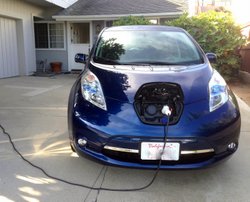
A short six years ago Nissan launched the Leaf during a time when electric vehicles (EVs) were a curiosity and under no stretch of the imagination guaranteed to still be around in 2016. Fast forward to today where one auto manufacturer (Tesla) offers only EVs, another dozen offer at least one, there is an international racing series that uses all-electric cars, and city buses, trash trucks and delivery vehicles are being electrified. Even the Port Of Los Angeles is pushing to require that all of the trucks that haul containers from ships to over-the-road carriers be electric-powered. Please, no jokes about not knowing that extension cords could stretch that far.
When Clean Fleet Report first reviewed the 2013 Leaf, we noted that Nissan may be the most honest car company out there because you would actually hear them say a Leaf may not be the right car for you. When we did an update on the launch of the 2016 Leaf, we brought the news of longer battery life and driving range. So did the improvements on battery charge and driving distance change Nissan’s candor that the Leaf might not be for you? Maybe they didn’t go that far, but we feel an EV is getting closer to your garage than you may think.
The biggest change for the 2016 Nissan Leaf SL is that the EPA-estimated driving range has increased from 84 to 112 miles on a full charge, a 33-percent increase compared to the 2015 model. To get this increased range you have to opt for the Leaf SL or SV models (the base model Leaf S with the smaller battery has an 84-mile driving range).
Operating and driving the 2016 Leaf SV or SL with the 112-mile driving range remains the same as the 2015 Leaf with the 84-mile range.
The New Battery
The SV and SL now have a 30kWh Lithium-Ion battery, up from a 24kWh battery, and a 6.6 kW onboard charger with a Hybrid System heater. All models have an 80 kW AC Synchronous motor with 107 hp and 187 lb-ft of torque. Charging the Li-ion battery is accomplished through a regenerative braking system and two plug-in ports offering three charging speeds:
- Trickle 110V – 21 hours: Discharged to a full charge
- Normal 220V – 4 – 7 hours: Discharged to a full charge
- Quick 480V – 30 minutes: Discharged to an 80% charge
The regenerative braking system converts braking or coasting into electricity, which charges the battery. The 2016 Nissan Leaf offers three forward drive options—Normal, ECO and B-mode, with
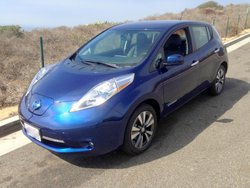
B-mode engaging the regenerative braking more aggressively when decelerating. You will come to enjoy monitoring the battery charge and mileage range (metered instantly with dashboard gauges) when driving around town or coasting down hills.
It is quite common to start an in-town journey of stop-and-go driving only to return with more or only a few miles depleted from the beginning range. However, where the regenerative braking system does not offer any help in charging the battery or adding to the driving range is the open freeway. Cruising along at 55 – 65 mph over an extended period will result in the battery charge and driving range being depleted right before your eyes. And if you decide to drive like everyone else on the freeways (at least in SoCal where I live), then you will be tempted to drive upwards of 75 mph, which will have a decidedly negative effect on your battery charge and driving range.
Leaf Driving Is Different
So how do you drive a Leaf efficiently? The first goal is to keep it as close as possible to fully charged before starting out on any length trip. Then, before even getting into the car, do some simple math to calculate the distance you will be driving before you will have the ability and time to plug-in again. With the regenerative braking system, if you hit enough slow traffic or traffic lights, either during rush hour or in-town driving, you might use very little of your starting driving range. If you are driving on the freeway in the 55 – 65+ mph range, then your range and battery life will be depleted in direct correlation to how fast you are driving.
Nissan’s “No Charge to Charge” program, offered in 48 cities, allows new Leaf owners free charging for the first two years of ownership. These fast charge stations can get you up-to 80-percent battery capacity in as little as 30 minutes.
If you live in California and are a AAA member (check your State’s local AAA club), one other safety net is that you can get an emergency quick charge from one of the organization’s service trucks. Just like if you ran out of gasoline and AAA dumped a five-gallon can of gas in your tank, select AAA trucks are equipped with a 480V generator that will give you about 20 miles driving to get you to a dealer or other charge station.
Driving Impressions
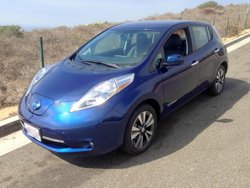
The 2016 Nissan Leaf SL comes with 17-inch, five-spoke aluminum-alloy wheels, all-season tires, MacPherson independent strut front suspension and torsion beams in the rear, with stabilizer bars at both ends and electronic stability and traction control. Combine this with a low center of gravity (because the batteries are under the seats) and this car handles very well without body roll, even on the tightest of corners. The tight turning radius of 17 feet handles most neighborhood streets without resorting to a three-point turn.
Regenerative braking systems can sometimes be grabby as they are not only stopping the car but converting energy to electricity. But the Leaf’s four-wheel antilock, vented disc brakes with ABS, brake assist and electronic brake force distribution stopped straight and true.
The Leaf gets-up-and-goes with smooth acceleration and 100-percent torque at any speed through the direct drive single-speed reduction gear, an EV’s version of a transmission. Merging onto SoCal freeways and getting up to 65 mph were not an issue. Once cruising at freeway speeds, the Leaf is quiet—more like silent—and smooth with only minor wind noise. The low 0.29 drag coefficient comes from underbody flat panels and diffusers, a rear roof spoiler and those “bug” headlights that are designed to redirect the airflow away from the car. The result of all this, with the lightweight wheels and low rolling resistance tires, delivers an aerodynamic and extremely fuel efficient driving experience.
At low speeds the Leaf emits a whirring sound to alert pedestrians that this completely silent car is nearby. In reverse, a pleasant version of the annoying beeper found on trucks lets people know the Leaf is backing up. Both are very useful as driving an all-electric car includes the responsibility of realizing that no one knows you are there and that you need to protect them.
Interior
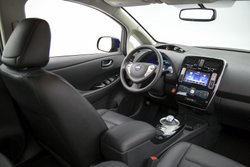
Finding a comfortable seating position with the leather-appointed (SL trim level only), heated, six-way, manually adjustable driver’s seat (the front passenger gets a four-way manually adjustable seat) and adjustable steering wheel was easy. Headroom in the front is ample, even for the tallest drivers. The front bucket/rear bench seats can accommodate five adults with good head and leg room, especially since the batteries are located under the seats and the charger is up front. One interesting feature of the heated rear seat, which folds 60/40, is that the bottom cushion is raised a few inches above the front seat height, providing for an almost theater experience for your friends riding out back. The large glass area provides an open, airy feeling with good visibility.
Pushing the Start button results in a pleasant chime that lets you know the car is ready to be driven. You need to wait a few seconds and read the dash to make sure you are ready to set off as there is no indication from noise or vibrations that the Leaf is good-to-go. The two-level dash layout includes all the gauges necessary to monitor driving range and battery charge levels with the video screen centered for easy reach and viewing. The gear selector is a round knob in the center console that gives you the aforementioned four options—Park, Drive, B-Mode and Reverse—and is operated similar to a joystick. Nissan has designed a simple to understand and use cockpit with all buttons, knobs and switches within easy reach.
As mentioned earlier, the 2016 Nissan Leaf is quiet to operate as there are no engine or transmission noises. With the power windows closed, the cold A/C running and the excellent Bose Premium sound system providing cool tunes, this all adds-up for a very quiet cabin environment. I was driving the fully optioned SL model which came with voice activation in a seven-inch color LCD display, the BOSE Premium seven speaker audio system with USB port for iPod and other mobile devises, HD AM/FM/CD/Aux and Pandora, telephone and hands-free text messaging via Bluetooth, Homelink and SiriusXM, which comes with a three-month complimentary service. Intelligent Key allows for locking/unlocking the front doors with the push of a button on the door handle.
Navigation is part of the Nissan Connect service, which includes mobile apps and the ability to connect with the car remotely. Through Nissan’s Carwings Telematics technology you can monitor the battery’s charge status and charge start time and even turn-on the HVAC system.
The seven-inch monitor also provides views from the rearview camera and Nissan’s Around View Monitor system, which is a series of cameras strategically located on the exterior of the Leaf that allows the driver to see completely around the vehicle, as if looking down from above.
Exterior
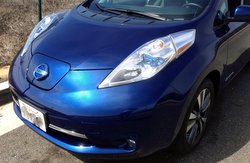
When you look at the 2016 Nissan Leaf SL one thing comes to mind: aerodynamics. This car was built to slip through the wind with the least amount of resistance. The most critical comments center around the headlight design, but just like the Mini dash and the Nissan Juke front end, all styling tastes are personal and you will either like the Leaf headlights or not. Otherwise, the car has an identifiable contemporary shape with four doors and rear hatch. The charging door on the nose has a lock and light.
Safety, Comfort and Warranties
When taking delivery at the dealership, there is a lengthy education and introduction process provided by a Nissan factory trained Leaf Specialist. You will learn about all the systems, charging, driving and safety aspects of owning an all-electric vehicle.
The SL model has all the comfort and safety features you would expect on a nicely optioned car such as front, side and roof-mounted (curtain) air bags, anti-theft alarm system with engine immobilizer, automatic temperature control, cargo cover, carpeted floor mats, heated and tilting steering wheel, power and heated outside mirrors, power door locks and one-touch power windows, fog lights, LED headlights and a Photovoltaic solar panel (for charging the 12V battery) mounted on the roof spoiler, tire pressure monitor system with the Easy Fill tire alert, vehicle dynamic control and traction control systems.
The 2016 Leaf comes with these warranties:
Basic – Three years/36,000 miles
Li-ion Battery – Eight years/100,000 miles
EV System – Five years/60,000 miles
Powertrain – Five years/60,000 miles
Corrosion/Perforation – Five years/Unlimited Mileage
All 2016 Leafs have earned a US Government National Highway Traffic Safety Administration (NHTSA) 4-Star Overall Vehicle Score, where 5 Stars is the highest safety rating, and the Insurance Institute for Highway Safety (IIHS) gave the Leaf an overall Good rating.
Pricing
Clean Fleet Report tested the fully optioned 2016 Nissan Leaf SL model with a MSRP of $38,540. Depending where you live and your taxable income, you could potentially
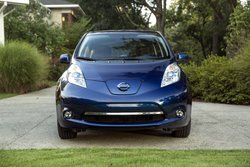
reduce your final cost by as much as $10,000 through Federal and State programs. It is recommended contacting your CPA before considering a Leaf purchase so you are completely clear on the tax credits. Not relying on the dealer to provide this information will serve them and you best.
Leaf pricing before any federal or state incentive programs or the destination charge of $850 is:
Model S $29,010
Model SV $34,200
Model SL $36,790
For those in California, the Leaf automatically qualifies for the coveted HOV sticker, which allows driving in the Carpool lane even with just the driver. If you haven’t heard the stories, people buy the Leaf just for this benefit.
Observations: 2016 Nissan Leaf SL
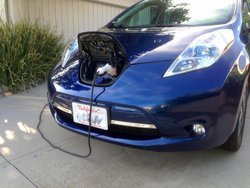
The 2016 Nissan Leaf SL drives and handles as good, or better, than a conventionally powered car and is very, very quiet. Therefore, placing it on your shopping list comes down to how far do you drive and would this be your primary vehicle. If you fall into that 90-100 mile round trip (or a similar distance one-way with a charging station already picked out) driving range, then the Leaf should be seriously considered.
You will enjoy the smooth ride with tight turning and the instant torque at any speed. The Leaf delivers a comfortable ride experience with peppy acceleration and can comfortably carry four full-size adults.
What you will enjoy and embrace is whizzing by gas stations and not having to pay attention to the odometer for your next oil change or major service appointment.
Much debate continues on whether owning an electric or hybrid vehicle makes financial sense, and the payback timeline. Early EV and hybrid owners were trendsetters, but that has all changed. Because of improved range and technological advances, consumers today are buying an EV (or hybrid) because of its drivability, comfort, performance and, of course, its low impact on the environment and the reduction of the use of fossil fuel. This “Statement Ownership” has been recognized and encouraged by the government through tax breaks on electric vehicles and home fast-charging systems.
So, where do you fit in as a future EV owner? If the majority of your driving is the in-town or close-in freeway and you have access to a conventionally powered car, then you are the perfect candidate to purchase an EV. Make sure to take a lengthy test drive, which replicates your longest and most common trip, as this is the only way to truly see if the Nissan Leaf is right for your lifestyle.
And of course…Happy Driving!
Related Stories You Might Enjoy:
Update: 2016 Nissan Leaf
Road Test: 2013 Nissan Leaf
Road Test: 2016 Fiat 500e
The Best-Selling Electric Cars in the U.S.
Road Test: 2014 Ford Focus Electric
Road Test: 2014 Volkswagen e-Golf
Road Test: 2014 BMW i3 & i3 REX
First Drive: 2015 Kia Soul EV
Disclosure:
Clean Fleet Report is loaned free test vehicles from automakers to evaluate, typically for a week at a time. Our road tests are based on this one-week drive of a new vehicle. Because of this we don’t address issues such as long-term reliability or total cost of ownership. In addition we are often invited to manufacturer events highlighting new vehicles or technology. As part of these events we may be offered free transportation, lodging or meals. We do our best to present our unvarnished evaluations of vehicles and news irrespective of these inducements.
Our focus is on vehicles that offer the best fuel economy in their class. We also feature those that are among the top mpg vehicles in their class. In addition, we aim to offer reviews and news on advanced technology and the alternative fuel vehicle market. We welcome any feedback from vehicle owners and are dedicated to providing a forum for alternative viewpoints. Please let us know your views at publisher@cleanfleetreport.com.

8 thoughts on “Road Test: 2016 Nissan Leaf SL”